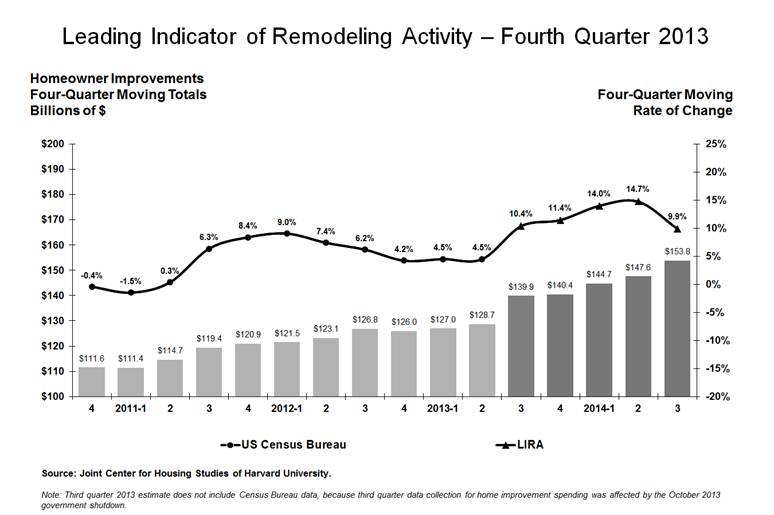The strong growth in the home remodeling market which began in the second quarter of 2013 will continue through the first half of 2014 according to LIRA, the Leading Indicator of Remodeling Activity. LIRA is a tool developed by the Remodeling Futures Program at the Joint Center for Housing Studies at Harvard University.
The current LIRA projection extends the expected remodeling boom out into the future by an additional quarter beyond projections issued in October. The rate of that growth has been downgraded however from October estimates.
LIRA now expects that double digit gains in spending will continue through the first half of the year and then moderate to just under 10 percent by the third quarter. However, a gain of 15.9 percent in the three month moving average to $146.1 billion originally predicted for Q4 2013 is now put at 11.4 percent and $140.4 billion.
Looking forward the new projections are also more restrained. The original estimate of a 17.3 percent moving average increase in the first quarter is now 14.0 percent and 16.2 percent in Q2 has become 14.7 percent. By the end of the second quarter LIRA estimates home improvement spending at $147.6 billion before growth moderates to a moving average of 9.9 percent in Q3.

"The ongoing growth that we've seen in home prices, housing starts, and existing home sales is also being reflected in home improvement activity," says Eric S. Belsky, managing director of the Joint Center. "As owners gain more confidence in the housing market, they are likely to undertake home improvements that they have deferred."
"However, the strong growth for this cycle may start to ebb a bit beginning around midyear," says Kermit Baker, director of the Remodeling Futures Program at the Joint Center. "By that time, we'll be approaching the pre-recessionary levels of spending, and with borrowing costs starting to creep back up, growth rates are likely to slow some."
LIRA is designed to estimate national homeowner spending on improvements for the current quarter and subsequent three quarters. The indicator, measured as an annual rate-of-change of its components, provides a short-term outlook of homeowner remodeling activity and is intended to help identify future turning points in the business cycle of the home improvement industry.







